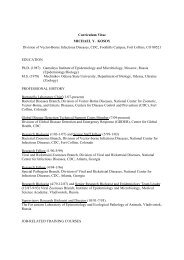Curriculum vitae: Maria Rita Palombo
Curriculum vitae: Maria Rita Palombo
Curriculum vitae: Maria Rita Palombo
You also want an ePaper? Increase the reach of your titles
YUMPU automatically turns print PDFs into web optimized ePapers that Google loves.
72A. – <strong>Palombo</strong> M.R., Giovinazzo C. (2003) - Utilità dei cenogrammi nelle ricostruzioni paleoambientali: il caso<br />
dei complessi a mammiferi del tardo Pleistocene inferiore e del Pleistocene medio della Penisola italiana.<br />
Giornate di Paleontologia, Alessandria, maggio 2003: 38<br />
73A. – <strong>Palombo</strong> M.R., Valli A.M.F. (2003) - Similarities among Large Mammal Faunas of France from the<br />
Pliocene to the Middle Pleistocene. Giornate di Paleontologia, Alessandria, maggio 2003: 39<br />
74A. - <strong>Palombo</strong> M.R., Giovinazzo C. (2003) - Elephas falconeri from Spinagallo Cave (south-eastern Sicily,<br />
Hyblean plateau, Siracusa): brain to body weight comparison. Inter. Congress "Insular vertebrate<br />
evolution: the paleontological approach". Palma de Mallorca, Balearic Islands (Spain), 16- 19 Settembre<br />
2003:53<br />
75A. - <strong>Palombo</strong> M.R., Abbazzi L., Angelone C., Arca M., Barisone G., Bedetti C., Delfino M., Kotsakis T.,<br />
Marcolini F., Pavia M., Piras P., Rook L., Torre D., Tuveri C., Valli A.M.F. & Wilkens B., (2003) - Plio-<br />
Pleistocene fossil vertebrate of Monte Tuttavista (Orosei, Eastern Sardinia, Italy): new perspectives for<br />
insular ecosystem evolution. Inter. Congress "Insular vertebrate evolution: the paleontological approach".<br />
Palma de Mallorca, Balearic Islands (Spain), 16- 19 Settembre 2003: 51-52<br />
76A. – <strong>Palombo</strong> M.R. (2003) – Food Habitus of “Megaceroides” cazioti (Deperet, 1911) from Dragonara Cave<br />
(Sardinia, Italy) inferred by cranial morphology and tooth wears. Inter. Congress "Insular vertebrate<br />
evolution: the paleontological approach". Palma de Mallorca, Balearic Islands (Spain), 16- 19 Settembre<br />
2003: 49<br />
77A. – <strong>Palombo</strong> M.R., Ginesu S., Melis R.T., Sias S. (2003) – The endemic Elephants from Sardinia, an unsolved<br />
problem. Inter. Congress "Insular vertebrate evolution: the paleontological approach". Palma de<br />
Mallorca, Balearic Islands (Spain), 16- 19 Settembre 2003: 5<br />
78A. – Melis R.T., <strong>Palombo</strong> M.R. (2003) – Plio-Pleistocene environments and mammal records on Western and<br />
Central Sardinia:an overview. Inter. Congress "Insular vertebrate evolution: the paleontological<br />
approach". Palma de Mallorca, Balearic Islands (Spain), 16- 19 Settembre 2003:40<br />
79A. <strong>Palombo</strong> M.R. (2003) - Dwarfing in insular mammals: the endemic elephants of mediterranenan island.<br />
“Geoitalia 2003”, Bellaria, settembre 2003: 45-47<br />
80A. – <strong>Palombo</strong> M.R. (2003) – Similarities among large mammal faunas of Italian peninsula from the Pliocene to<br />
the Middle Pleistocene. “Geoitalia 2003”, Bellaria, settembre 2003: 47-49<br />
81A. – <strong>Palombo</strong> M.R., Ginesu S., Sias S. (2003) – Nuovi resti di Mammuthus lamarmorai (Major, 1883) nei<br />
depositi alluvionali del Pleistocene medio di Campu Giavesu (Sardegna Nord-occidentale). “Geoitalia<br />
2003”, Bellaria, settembre 2003:49-51<br />
82A – <strong>Palombo</strong> M.R., Giovinazzo C. (2003) Struttura ecologica dei complessi a mammiferi del Pleistocene medio<br />
della penisola italiana. “Geoitalia 2003”, Bellaria, settembre 2003:51-53<br />
83A. – <strong>Palombo</strong> M.R., Ginesu S., Sias S. (2003) – Mammuthus lamarmorai (Major, 1883) remains in the Middle<br />
Pleistocene alluvial deposits of Campu Giavesu plain (north western Sardinia, Italy). Occasional Paper in<br />
Earth Science, Abstracts 3 rd Int. Mammoth Conf., 2000: 122-125<br />
84A.. – <strong>Palombo</strong> M.R., Azanza B., Alberdi M.T. (2003) – Large mammal turnover, diversità and Elephant dispersal<br />
in the Western Mediterranean: the Italian and Iberian peninsulas. Occasional Paper in Earth Science,<br />
Abstracts 3 rd Int. Mammoth Conf., 2000: 117-122<br />
2004<br />
85A. – <strong>Palombo</strong> M.R. (2004) Enigmatici Sardi: 200 anni di ricerche sui mammiferi fossili per una storia di 50<br />
milioni di anni. Seminari di Paleontologia dei Vertebrati, Cagliari 28-30 gennaio 2004: 4-6<br />
86A. – <strong>Palombo</strong> M.R. Giovinazzo C. (2004) - Brain weight versus body mass in Late Pleistocene Cynotherium<br />
sardous Studiati, 1847 from Dragonara Cave (North-Western Sardinia). Giornate di Paleontologia.<br />
Bolzano, maggio 2004: 44<br />
87A. – <strong>Palombo</strong> M.R. (2004) - Biochronology of the Plio-Pleistocene mammalian faunas of Italian peninsula:<br />
knowledge, problems and perspectives. AIQUA congresso “Luci ed ombra della Geologia”, Roma febbraio<br />
2004 : 59-60<br />
88A. – <strong>Palombo</strong> M.R. (2004) - The evolution of herbivore and carnivore guilds in Italy from the Late Neogene to<br />
the Late Pleistocene. Terra Nostra 2004/2, 18th int. Senck. Conf., Weimar: 196-197<br />
89A. – <strong>Palombo</strong> M.R., Ferretti M., (2004) - Steppe mammoth occurrence from Italy. Terra Nostra 2004/2, 18th int.<br />
Senck. Conf., Weimar: 198<br />
90A. – <strong>Palombo</strong> M.R., Giovinazzo C. (2004) - What do cenograms tell us about the mammalian palaeoecology?<br />
The example of Plio-Pleistocene Italian faunas. Terra Nostra 2004/2, 18th int. Senck. Conf., Weimar: 199-<br />
200<br />
19



